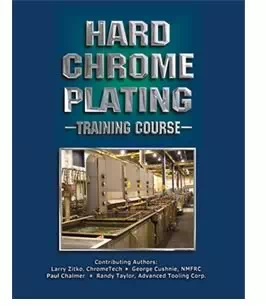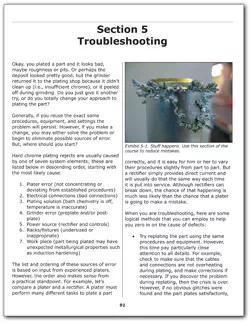
Hard chrome plating is one of the trickiest metal finishing processes to master. There are many possible pitfalls. But if you learn the fundamentals, and learn how to apply them to your work, you will be well on your way to being a skilled hard chrome plater and producing quality parts.
This 167 page book is an innovative method of learning the science and art of hard chrome plating. This book, written by a group of national experts, will not only teach you the details of hard chrome plating, it will also serve as a coveted reference book for many years to come.
This course covers chrome plating in a different way. Good information sources are available for engineers and for chemists. But there are few referencesthat have been written particularly for the people who have to load the racks and set the controls, or for those responsible for making sure the job is being done right.
Scope
The hard chrome plating course is divided into eight sections. After each section, you will find a quiz. These quizzes will help you evaluate how well you learned the material presented in the course. Answers to the quizzes are in an appendix.
- Section 1. Course Overview
- Section 2. Introduction to Hard Chrome Plating. Nickel, copper, silver, zinc, or other electroplated metals all play an important role in manufacturing. However, there is something special about hard chrome that makes it a first-class process. Maybe it’s the hardness or durability of hard chrome, or perhaps the wide range of important functions it plays in aircraft, engines and machinery. This section provides an introduction to a world of possibilities.
 |
Sample Section
Download Section 5. Troubleshooting. This section gives you tools to help figure out what went wrong and how to correct it. |
- Section 3. Process Chemistry and Equipment. You don’t need to be a chemist or an electrical engineer to plate hard chrome, but having a basic understanding of process chemistry and electroplating equipment will help you be a better plater. This section provides some fundamentals that will help you through the rest of the course.
- Section 4. Plating Procedures. This section of the course covers the range of hard chrome procedures you will need to successfully plate most of the parts you encounter. It starts with a discussion of pre-plating procedures, such as cleaning and masking. We then cover plating, and finally conclude with post-plating procedures, such as hydrogen embrittlement relief.
- Section 5. Troubleshooting. If you follow good plating procedures, your parts will usually have a uniform bright chromium deposit. However, sooner or later, you are going to generate a mis-plated part. This section gives you tools to help figure out what went wrong and how to correct it.
- Section 6. Plating Bath Fitness. Hard chrome baths are durable, but they can go out of whack if you don’t follow preventative measures and correct problems before they get out of hand. This section will help you keep your bath in top shape, resulting in faster plating rates and brighter deposits.
- Section 7. Health and Safety. There are significant health and safety risks associated with hard chrome plating. Rules exist that must be followed to meet federal and state regulations. However, beyond just meeting these standards, you need to be aware of the potential dangers and take the proper precautions. This section will help you be a safe and healthy hard chrome plater.
- Section 8. Pollution Prevention. Plating shop wastes are costly to manage, cleanup and dispose of, and they can have a severe impact on our environment. This section emphasizes pollution prevention, which means reducing the quantity of waste generated. It is much more efficient to avoid generating waste than to deal with it later.
- Appendices. At the end of this book there are a set of appendices that contain important information and data that will make your job a bit easier. You will make use of these during the course and you will want to keep them for future reference.
|








